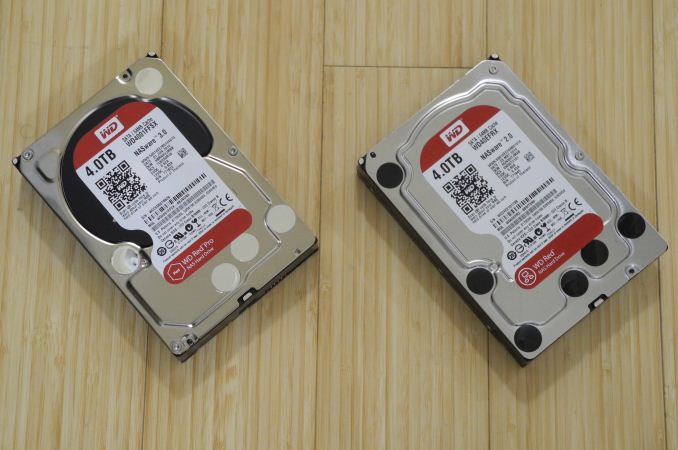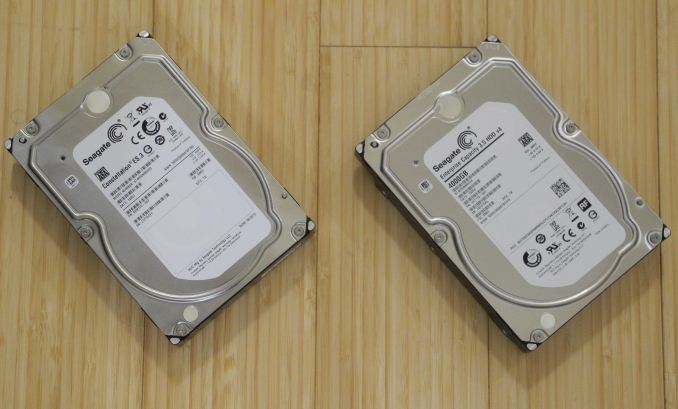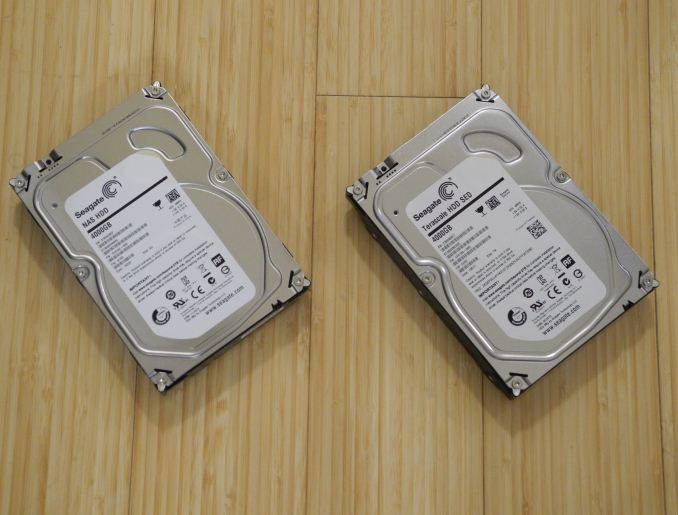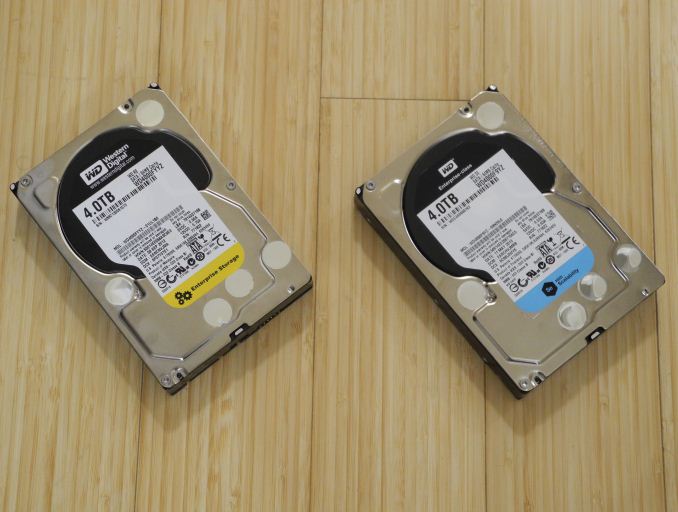WD Red Pro Review: 4 TB Drives for NAS Systems Benchmarked
by Ganesh T S on August 8, 2014 9:00 AM EST4 TB NAS and Nearline Drives Face-Off: The Contenders
Prior to getting into the performance evaluation, we will take a look at the special aspects and compare the specifications of the ten drives being considered today.
Western Digital Red Pro 4 TB
The Red Pro is meant for 8-16 bay SMB / SME rackmount units. Compared to the WD Red, it has better performance, thanks to its 7200 RPM rotational speed. While the WD Red has utilized 1 TB and 1.2 TB / platter configurations, the Red Pro units have 600 GB and 800 GB platters for the 2 / 3 TB versions and the 4 TB version respectively. The lower areal density platters have been in production for quite some time, allowing Western Digital to use a more mature configuration for the Red Pro parts. Like the enterprise drives, the Red Pro comes with hardware-assisted vibration compensation, undergoes extended thermal burn-in testing and carries a 5-year warranty.
Western Digital Red 4 TB
The 4 TB WD Red that we evaluated for this piece is the same as the one that we used in last year's roundup, i.e, the NASware 2.0 version and not the NASware 3.0 version. Even though the WD Reds initially targeted 1-5 bay systems, NASware 3.0 updates the vibration handling mechanism (firmware / calibration) to enable usage in 1-8 bay units. Despite the firmware not being upgradable for older models, WD is honouring warranties even if the NASware 2.0 drives are used in 6-8 bay units. Other aspects of the WD Red models have already been touched upon in our previous reviews.
Seagate Constellation ES.3 4 TB
The Constellation ES.3 lineup is last year's enterprise play (sixth-generation) from Seagate in this market space. It targets applications where capacity, performance and durability under heavy workloads are primary considerations. The drives have a standard 7200 RPM spindle speed, but differ from other units by having a 128 MB multi-segmented cache on-board (64 MB is the standard nowadays). All models are 512N (i.e, native 512 bytes per sector, enabling usage without performance loss for legacy applications).
Seagate Enterprise Capacity 3.5" HDD v4 4 TB
The Enterprise Capacity 3.5" HDD features Seagate's eighth generation drive technology and retains the 128 MB cache of its predecessor. The main difference is that there are no 512N models (either 4K native for the 6 TB model, and 512 emulated for the others). Seagate happens to be the first to use 1 TB platters for its enterprise drives, and this has enabled the Enterprise Capacity lineup to include 6 TB variants. For this review, we managed to get hold of the 4 TB version. On the basis of paper specifications, it looks to be a very good alternative to the WD Red Pro.
Seagate NAS HDD 4 TB
The NAS HDD lineup goes head-to-head against the WD Red. The slightly higher spindle speeds (5900 RPM vs. 5400 RPM) tends to give it the performance advantage at the cost a slight power consumption penalty. Seagate implements the NAS-specific firmware features as part of the NASworks package. We have looked into various features of the NAS HDD lineup in our previous roundup.
Seagate Terascale SED 4 TB
Seagate also supplied us the Terascale drives for this roundup, since we had the WD Se in our previous roundup. The Terascale (previously Constellation CS) goes head-to-head against the WD Se in all departments - it is meant for applications where scalability / capacity is a primary factor, followed by low power consumption and cost. Both 5900 and 7200 RPM versions are available, but our review units belonged to the former category and came with the Instant Secure Erase feature. Unlike the other Seagate enterprise drives in our review samples, this one comes with 64 MB of cache. Seagate claims lowest power consumption in the enterprise drive category for the Terascale drives.
Western Digital Re 4 TB
The Western Digital Re is meant to go head-to-head with the Seagate Constellation ES.3 and Enterprise Capacity 3.5" HDD v4. The application areas are the same - enterprise applications where performance, reliability and durability under heavy workloads are primary requirements. The Re drives are the highest-performing SATA drives from Western Digital. The Xe drives are a class above the Re, but they are available only in capacities of up to 900 GB and come with a SAS interface only. We have been using Re drives in all our NAS reviews so far.
Western Digital Se 4 TB
The Se drives come from WD's Datacenter Storage Business Unit and meant for applications where scalable storage (i.e, reliable storage which doesn't cost an arm and a leg for scenarios where capacity, rather than performance, is of primary importance). WD uses them in their own datacenter. Like other enterprise drives, they come with a self-encryption option and carry longer warranties. When compared to WD Re, the difference comes in the URE (unrecoverable error rates), MTBF ratings and suggested workloads. Further details can be seen in our launch coverage of the WD Se.
Toshiba MG03ACA400
The MG03ACA400 is Toshiba's highest capacity nearline storage device targeting enterprise applications. The specifications are standard - a 7200 RPM drive with a 64 MB buffer. Toshiba makes it clear that the drives target entry-level servers, storage arrays and RAID systems - There is no emphasis on extreme performance, so it is only fair to expect it to slot with the WD Se and Seagate Terascale drives rather than the Re and Enterprise Capacity ones. The street price (as of the time of this article going live) is similar to that of the Terascale, and this only reinforces our perception.
HGST Ultrastar 7K4000 SAS
The HGST Ultrastar 7K4000 is the odd-one out in our sample set today. We had requested HGST for the SATA version of the 7K4000, as that goes head-to-head with the Re, Constellation ES.3 and the Enterprise Capacity drives, but they only had the SAS interface version available for review sampling. The standout aspect of the Ultrastar lineup is the 2.0 million hours MTBF rating. Comparing SATA and SAS drives are like comparing apples and oranges, but, at least, we have the same 7200 RPM spindle speed and 64 MB buffer like most of the other drives. As mentioned in the previous section, we are only going to look at the RAID-5 performance benchmark numbers for this drive in today's review.















62 Comments
View All Comments
shodanshok - Sunday, August 10, 2014 - link
It is not a single post. It is a lengthy discussion of 18 different posts. Let me forward you to the first post: http://marc.info/?l=linux-raid&m=1406709331293...When used in single parity scheme, no RAID implementation or file system is immune to UREs that happen during rebuild. What ZFS can do it to catch when a disk suddenly return garbage, which with other filesystem normally result in silent data corruption.
But UREs are NOT silent corruption. They happen when the disk can not read the requested block and give you a "sorry, I can't read that" message.
Regards.
asmian - Sunday, August 10, 2014 - link
>But URE's are NOT silent corruption.They are if you are using WD Red drives, which Ganesh has previously said are using URE masking to play nicer with RAID controllers. They issue dummy data and no error instead of a URE. This, and the serious implications of it especially with single parity RAID (mirror/RAID5), is NOT mentioned in this comparative article, which is shocking.
To reiterate: if a RAID5 array (or a degraded RAID6) has a masked URE, there is no way to know which disk the error came from. And if the controller is NOT continuously checking parity against all reads for speed then the dummy data will be passed through without any error being raised at all. Worse, since you don't know there has been a read error, you will assume your data is OK to backup, so you will likely overwrite good old backups with corrupt data, since space for multiple copies is likely to be at a premium, so any backup mitigation strategy is screwed.
Given the fact that these are 4GB consumer class drives with 1 in 10^14 URE numbers, the chance of a URE when rebuilding is very high, which is why these Red drives are extremely unsafe in RAID implementations that do NOT check parity continuously. I already ran the numbers in a previous post, although they haven't been verified - Ganesh said he was seeking clarification from the manufacturers. Bottom line: caveat emptor if you risk your data to these drives, with or without RAID or a backup strategy.
shodanshok - Sunday, August 10, 2014 - link
Can you provide a reference about URE masking? I carefully read WD Red specs (http://www.wdc.com/wdproducts/library/SpecSheet/EN... and in no place they mention something similar to what you are referring. Are you sure you are not confusing URE with TLER?After all, I find extremely difficult to think that an hard drive will intentionally return bad data instead of a URE.
The only product range where I can _very remotely_ find a similar thing useful is with WD Purple (DVR) series: being often used as simple "video storage" in single disk configuration, masking an URE will not lead to big problems. However, the proper solution here is to implement a configurable SCTERC o TLRE.
Regards.
asmian - Sunday, August 10, 2014 - link
> I find extremely difficult to think that an hard drive will intentionally return bad data instead of a URE.Ganesh wrote to me: "As discussed in earlier WD Red reviews, the drive hopes to tackle the URE issue by silently failing / returning dummy data instead of forcing the rebuild to fail (this is supposed to keep the RAID controller happy)."
shodanshok - Sunday, August 10, 2014 - link
This seems more the functionality of TLER, rather than some form of URE masking. Anyway, if the RED drive really, intentionally return garbage instead of a read error, it should absolutely avoided.Ganesh, can you clarify this point?
asmian - Sunday, August 10, 2014 - link
A quick search back through previous WD Red drive reviews reveals nothing immediately. Ganesh ran a large article on Red firmware differences that covered configurable TLER behaviour, which is about dropping erroring drives out of an array quickly so that the array parity or other redundancy can take over and provide the data that the drive can't immediately retrieve, but nothing like this was mentioned.However, in http://www.anandtech.com/show/6083/wd-introduces-r... the author Jason Inofuentes wrote: "They've also included error correction optimizations to prevent a drive from dropping out of a RAID array while it chases down a piece of corrupt data. The downside is that you might see an artifact on the screen briefly while streaming a movie, the upside is that you won't have playback pause for a few seconds, or for good depending on your configuration, while the drive drops off the RAID to fix the error."
That sounds like what Ganesh has said, although I can't see anything in his articles mentioning it. It may be a complete misunderstanding of the TLER behaviour, though. The problem with the behaviour described above is that it assumes that the data is not important, something that will only manifest as a little unnoticed corruption while watching a video file. But what if it happens while you're copying data to your backup array? What if it's not throwaway data, but critical data and you now have no idea that it's corrupt or unrecoverable on the disk so you NEED that last good backup you took... I don't think ANYONE is (or should be) as casual as that about the intrinsic VALUE of their data - why bother with parity/mirror RAID otherwise? If the statement is correct, it's extremely concerning. If not, it needs correcting urgently.
Zan Lynx - Monday, August 11, 2014 - link
To me that sounds like a short TLER setting. The description says nothing about if the drive returns an error or not. It may very well be the playback software receiving the error but continuing playback.asmian - Monday, August 11, 2014 - link
But a short TLER is designed specifically to allow the array parity/redundancy to kick in immediately and provide the missing data by reconstruction. There wouldn't BE any bad data returned (unless there was no array redundancy). So as described this is NOT anything to do with short TLER. It is about the drive not returning an error when it can't read data successfully (ie. a URE), and issuing dummy data instead. The fundamental issue is that without an error being raised, neither the array hardware/software nor the user can take any action to remedy the data failure, whether that's restoring the bad data from backup or even highlighting the drive to see if this is a pattern indicative of likely failure.There are some comments about it in that article which try to explain the scope (it seems to be limited to some ATA commands), but not in sufficient detail for me or most average users who don't know what ATA commands are sent by specific applications or the file system, and they certainly didn't answer my questions and misgivings.
shodanshok - Monday, August 11, 2014 - link
Hi, it seems more as a short TLER timeout rather than URE masking. Ganesh, can you clarify?ganeshts - Saturday, August 23, 2014 - link
Yes, shodanshok is right ; TLER feature in these NAS drives is a shorter timeout rather than URE masking. Ian's quote of my exchange in a private e-mails was later clarified, but the conversation didn't get updated here:1. When URE happens, the hard drive returns an error code back to the RAID controller (in the case of devices with software RAID, it sends the error back to the CPU). The error code can be used to gauge what exactly happened. A fairly detailed list can be found here: http://en.wikipedia.org/wiki/Key_Code_Qualifier : URE corresponds to a medium error with this key code description: "Medium Error - unrecovered read error"
2. Upon recognition of URE, it is up to the RAID controller to decide what needs to be done. Systems usually mark the sector as bad and try to remap it. It is then populate with data recovered using the other drives in the RAID array. It all depends on the vendor implementation. Since most off-the-shelf NAS vendors use mdadm, I think the behaviour will be similar for all of those.
3. TLER just refers to quicker return of error code back to controller rather than 'hanging' for a long time. The latter behaviour might cause the RAID controller to mark the whole disk as bad when we have URE for only one sector.